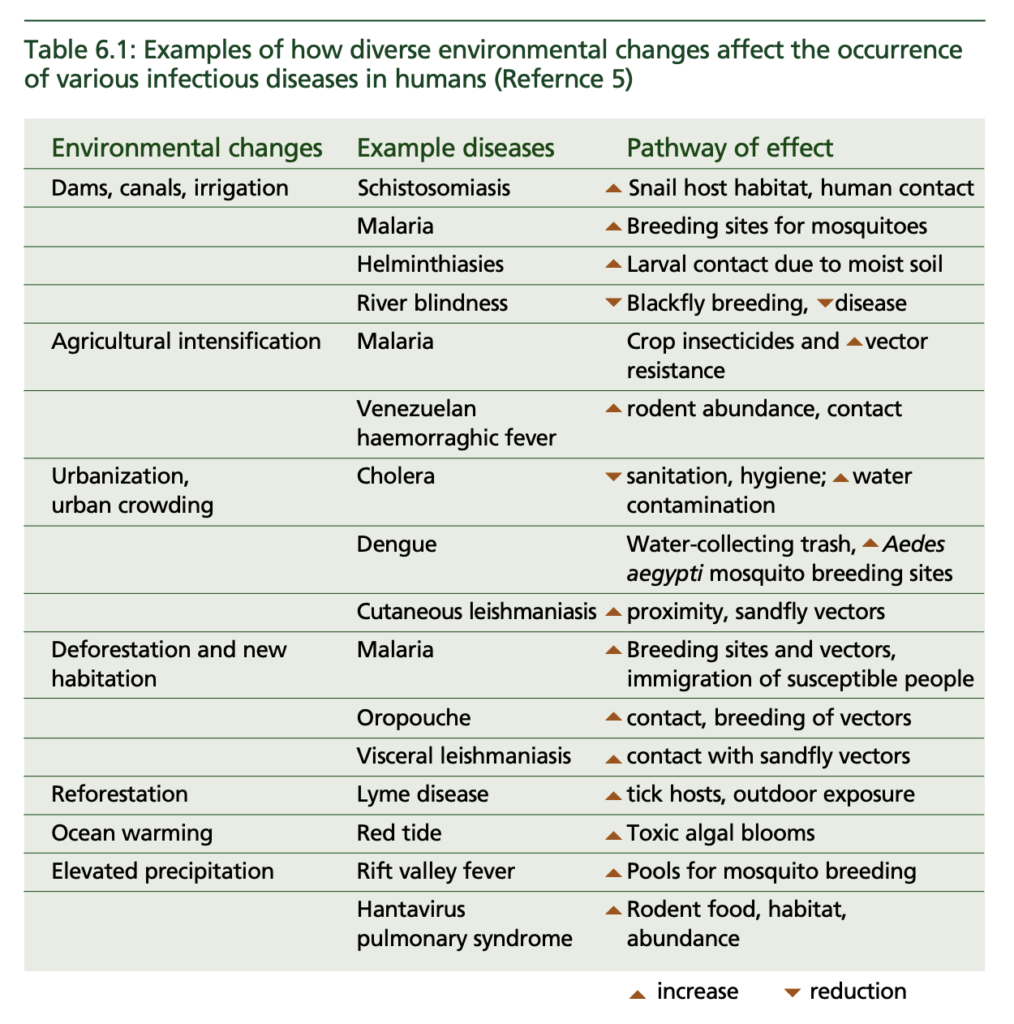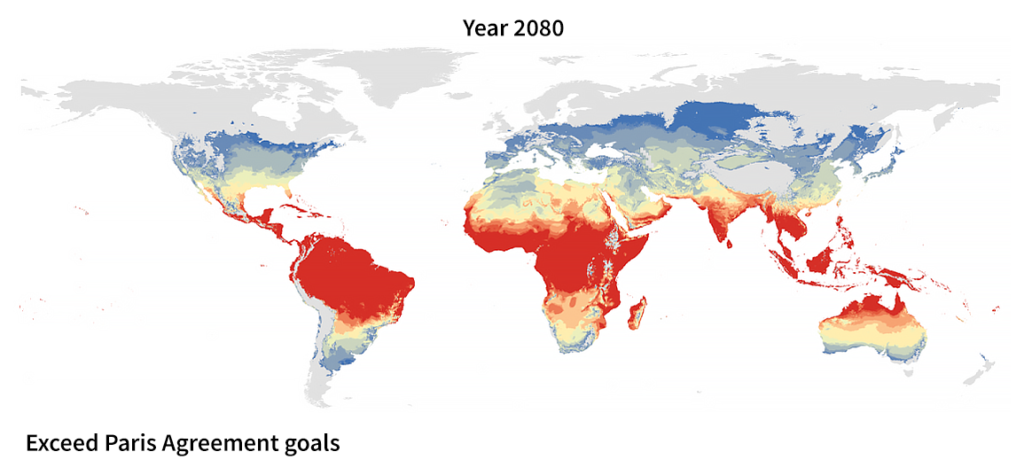The current global pandemic has caused many to ask questions on climate change, as a parallel crisis in need of much a stronger response than currently acknowledged, and as a key influencer in our health more broadly. Both crises already have, and will impact millions, exposing the links and tensions between global socio-economic and political inequalities. Within this, however, we have started to see more encouraging moments of change; most recently, our isolated lives have demonstrated that shifts in human behaviour are possible. The need for similar, persistent mass action in response to climate change is vital; a long-term commitment and engagement with the controllable variables that influence, manage and reduce damage to the planet, to definitively build global resilience.
A direct causal relationship between climate change and coronavirus is not certain, but for a number of climate sensitive diseases, such as malaria and dengue fever, the effects are unambiguous.
As we move closer to the irreversible thresholds of the Nine Planetary boundaries as created by Professor Rockstrom of the Stockholm Institute, change in weather patterns has, and is changing the spatial patterns of disease vectors. Increasing temperatures around the globe facilitate the spread of these vectors; despite thriving at an optimum of around 25 degrees celsius, mosquitoes, as with carrying various diseases, have adapted to a range of temperatures.

With temperature determining their growth and survival rates, rainfall affects the transport and dissemination of vectors. India has long been looked at as a case study on the link between malaria and extreme climatic events; excessive monsoon rainfall and high humidity is a major influence on enhanced mosquito dissemination and survival. With increasing global temperatures, the currently cooler, northern regions of the world could be affected by presently ‘uncommon’ diseases.

Predicted range of the Mosquito Aedes aegypti in 2080 if the world exceeds Paris Agreement Goals to reduce warming, Stanford Woods Institute for the Environment, 2019
Despite this, extreme climatic events still disproportionately devastate both the infrastructure and health of the world’s most vulnerable populations. Bangladesh’s Cyclone Amphan has highlighted the urgent need for climate change adaptation planning ; with 650,000 evacuations in the midst of the coronavirus pandemic, communities were hit hard from all angles. Atmospheric warming due to climate change is linked to higher frequency and intensity of cyclones, and the rising sea levels exacerbate storm surges, resulting in catastrophic flooding. The resulting damage from the Category 2 cyclone has destroyed an ecosystem which supports over 4 million people. Attempting to uphold social distancing whilst rehabilitating those affected demonstrates clearly the unsolved, complex overlap of climate change with all other facets of living.
Erin Modercai, a biologist at Stanford, has reinforced the need for prevention as opposed to reaction to the growing spread of disease, targeting the root of the cause to avoid ‘constantly playing a whack-a-mole with whatever the new emerging disease is’.
In this vein, tackling climate change must be viewed as a gateway to preventing a spectrum of short-term and long-term problems, health and otherwise; embedding resilience is key.
Activating change for the long-term, as opposed to reacting for the short-term, is a constant challenge in gaining traction for the climate change cause. Yet, the mass response to coronavirus has highlighted that a global effort is possible – current adaptation at both micro and macro levels of the population suggest that individual and group behavioural changes to combat a threat are achievable, a reassuring conclusion for climate change action. Enforced lockdowns have seen habitual changes with the added bonus of lowering global CO2 emissions. Chinese industry shutdowns in February saw emissions from the country plummet by an incredible 25 percent, and global emissions could fall by 5.5% compared to 2019 – a hopeful statistic given that YoY emissions have been on the increase.
‘We can already start seeing how the coronavirus pandemic may influence the pace and nature of climate action, and how climate action could accelerate the recovery by creating jobs, driving capital formation, and increasing economic resiliency.’
Milton Group’s work hones in on this thinking; facilitating the restoration, enhancement, and protection of nature’s assets as the pivot for embedding community resilience.
The ripple effects of coronavirus’ global transmission tells of the tangible shocks that a ‘full-fledged climate crisis’ could present – disruptions to supply chains, agile spread of disease – all effects that will ‘knock-on’ rapidly across our world with unequal distribution. As with the virus, climate change does not consider borders a stop sign, and the past few months have shed light on the inequalities and inadequacies of existing global infrastructures to cope with a crisis of this magnitude.
Despite the daunting parallels that can be drawn between the two crises, we can learn a lot from our experiences right now. Climate change needs to be approached with the same level of immediacy as has been seen for coronavirus – almost 500,000 people have died from coronavirus, yet according to WHO, air pollution alone kills 7,000,000 people every year. Government regulations and human fear are presently working hand-in-hand to proactively combat this pandemic and it’s time to comparably pull the climate crisis out of abstraction and into focus. We need to take an integrated approach to climate change that reinforces alignment and collaboration, and adheres to both human rights-based principles and principles of sound environmental management. Ultimately, we need to increase the resilience of both social and ecological systems in the face of a changing climate. Integrating this should be a priority for all leaders, as we start to create a new norm during these challenging times.
Nadine Manji, Milton Group Analyst
Sources:
https://www.stockholmresilience.org/research/planetary-boundaries/planetary-boundaries/about-the-research/the-nine-planetary-boundaries.html
https://earth.stanford.edu/news/how-does-climate-change-affect-disease#gs.78ahg4
https://www.who.int/globalchange/summary/en/index5.html
https://www.imperial.ac.uk/news/197473/how-will-coronavirus-shape-response-climate/
https://www.mckinsey.com/business-functions/sustainability/our-insights/addressing-climate-change-in-a-post-pandemic-world
https://www.who.int/emergencies/diseases/novel-coronavirus-2019
https://d2ouvy59p0dg6k.cloudfront.net/downloads/integrating_community_and_ecosystem_
based_approaches_in_climate_change_adaptation_res.pdf
https://blog.ei.columbia.edu/2020/05/26/cyclone-amphan-climate-adaptation/
https://www.carbonbrief.org/analysis-coronavirus-set-to-cause-largest-ever-annual-fall-in-co2-emissions


 By miltongroup, July 7, 2020
By miltongroup, July 7, 2020